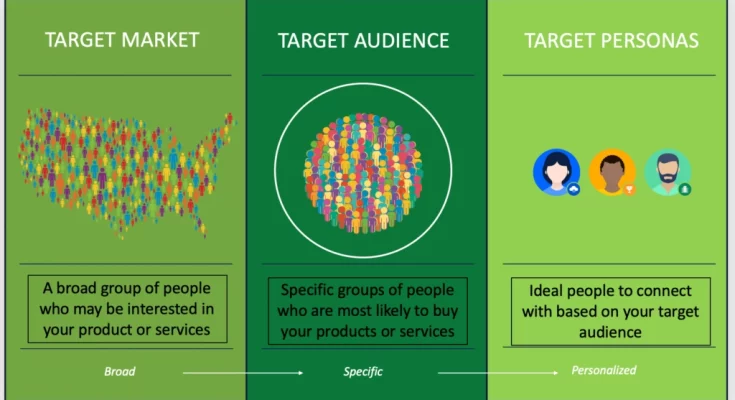Understanding your target audience is one of the most important steps in building a successful business or marketing strategy. Without a clear picture of who your audience is, you might find yourself wasting time and resources on marketing efforts that don’t yield the desired results. Whether you’re a new startup or an established brand, knowing exactly who your customers are, what they need, and how to reach them is critical for success.
In this article, we’ll walk you through the process of identifying your target audience and why it’s vital for the growth of your business.
1. Define Your Product or Service
Before you can identify your target audience, you need a clear understanding of what you’re offering. What problems does your product or service solve? What benefits does it provide? Understanding these elements helps you to know who would most benefit from your offering. For example, if you’re selling high-end skincare products, your target audience will likely be individuals who care about their appearance and are willing to invest in premium skincare.
-
Key questions to ask yourself:
-
What needs does my product address?
-
What are the unique features of my offering?
-
How does my product improve the lives of my customers?
-
Answering these questions will give you a solid foundation for identifying who will most benefit from your business.
2. Conduct Market Research
The next step in identifying your target audience is conducting thorough market research. This will help you gather insights about your potential customers’ behaviors, preferences, and demographics. Market research can be done in various ways:
-
Surveys and Questionnaires: Distribute surveys to your existing customers or potential customers to gain insights into their needs and preferences. Tools like Google Forms or SurveyMonkey make it easy to create and distribute surveys.
-
Competitor Analysis: Study your competitors to see who they are targeting and how they are positioning their products or services. Analyze their marketing strategies and their audience engagement to identify gaps or opportunities for differentiation.
-
Focus Groups: If feasible, organize focus groups with a small sample of people who resemble your ideal customers. This helps you get qualitative feedback on your product, your brand’s message, and your customer’s pain points.
3. Segment Your Audience Demographically
Demographics are one of the most straightforward ways to segment your audience. Demographic data includes characteristics such as age, gender, income, occupation, education, location, and family status. These data points help you narrow down who is most likely to buy your product or service.
-
Example of demographic segmentation: If you’re selling luxury travel experiences, your target audience may be high-income individuals aged 35-55 who are married and have an interest in exclusive travel destinations.
You can gather demographic data through social media insights, website analytics, and customer surveys.
4. Identify Psychographic Traits
Beyond demographics, psychographics help you understand the personality, values, and lifestyles of your target audience. Psychographic segmentation focuses on factors like:
-
Interests: What hobbies or activities do your potential customers engage in?
-
Values and Beliefs: What are the core values of your audience? For example, some customers might prioritize sustainability or ethical consumption.
-
Lifestyle: Are they busy professionals? College students? Retirees? Understanding how your audience lives will help you shape your marketing message.
Psychographics provide deeper insights into what motivates people to make purchasing decisions. They help you go beyond who your audience is, to what they care about.
5. Use Social Media Insights
Social media platforms have evolved into powerful tools for understanding and engaging with your audience. Platforms like Facebook, Instagram, Twitter, and LinkedIn provide detailed analytics that can give you valuable insights into your audience’s behavior.
-
Facebook Insights: Offers data on the age, gender, location, and interests of people who engage with your posts.
-
Instagram Insights: Provides similar data as Facebook, along with detailed information on what times your audience is most active.
-
Twitter Analytics: Tracks metrics such as engagement rate, demographics, and interests.
By utilizing these tools, you can get a snapshot of who is engaging with your brand and adjust your marketing efforts accordingly.
6. Analyze Customer Feedback and Behavior
Your existing customers are a wealth of information. By analyzing feedback from your current clients—whether it’s through customer reviews, social media comments, or direct feedback—you can uncover patterns in who they are and what they value. If customers are consistently asking for a particular feature, or if many of them share the same challenges, this gives you insight into who your target audience is.
-
Customer Behavior Analysis: Use tools like Google Analytics to analyze how visitors interact with your website. What pages are they visiting? How long do they stay? Which products or services are they engaging with the most? This information can help you identify key segments of your audience.
-
Customer Service Interactions: Take note of recurring questions or issues raised by customers during support interactions. These might highlight common concerns, preferences, or misunderstandings about your product or service.
7. Develop Customer Personas
Once you have gathered enough data, create customer personas—fictional representations of your ideal customers. Each persona should encapsulate the key characteristics of your target audience, including demographics, interests, pain points, and purchasing behavior. Having clear personas helps you better visualize who you’re marketing to and allows you to tailor your messaging accordingly.
For example, a persona for a high-end travel brand might look like this:
-
Name: Sarah, The Luxury Traveler
-
Age: 42
-
Occupation: Senior Executive at a tech company
-
Income: $150,000+
-
Interests: Exclusive resorts, spa treatments, gourmet dining
-
Challenges: Limited vacation time, seeks relaxation and luxury
-
Buying Behavior: Prefers high-quality, curated travel experiences over budget options
8. Test and Refine Your Approach
Identifying your target audience is an ongoing process. As trends and behaviors evolve, so should your understanding of your customers. Start by testing your assumptions—whether through small-scale marketing campaigns, focus groups, or A/B testing your website or ads—and refine your target audience based on the results.
-
A/B Testing: Run different versions of an ad, landing page, or email campaign to see which one resonates more with your audience.
-
Customer Feedback: Keep seeking feedback from your audience to ensure you’re aligned with their evolving needs and interests.
Conclusion
Finding your target audience is not a one-time task, but an ongoing process that requires constant research, testing, and refinement. Understanding who your customers are—and what they need—is crucial for developing products, services, and marketing messages that truly resonate. By following the steps outlined above, you can effectively define your target audience, connect with the right people, and create marketing strategies that drive results.
The key is to stay adaptable and continue gathering insights as your business grows, ensuring you’re always in tune with the ever-changing preferences and behaviors of your customers.




